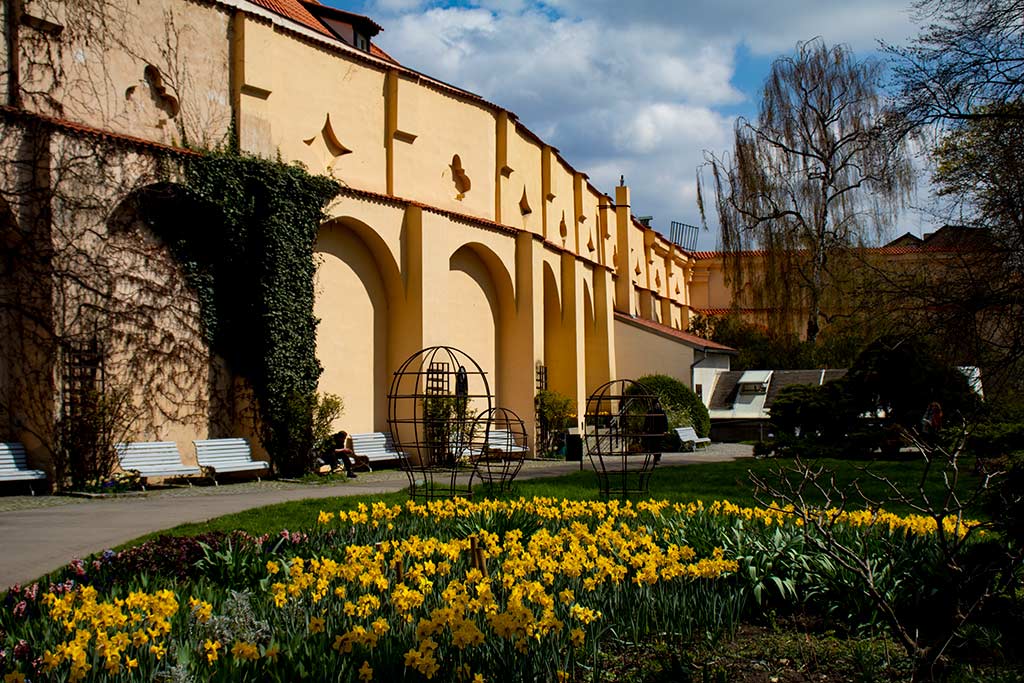This is my guide to Prague tram 22, one of the best and most popular tram routes in the Czech capital.
I take you on a full guided tour of the journey, which crosses Prague from east to west, including a run across the river Vltava with jaw-dropping views of Prague Castle.
I advise you on what to look out for as you travel on the 22 tram, as well as what to see near each of the tram 22 Prague stations.
In this guide I also show you how and where to get your Prague tram ticket, and advise on the best type of tram to travel on and where to sit to make the most of the views. Enjoy!
Why Ride Prague Tram 22


The 22 tram in Prague is one of the best – if not THE best – tram route in Prague.
It runs through the suburb of Vinohrady and New Town Prague, before crossing the spectacular Vltava River to the Mala Strana district.
It then climbs the hill to Prague Castle, before heading out past one of the finest Baroque churches in Prague to the site of one of the most important battles in Czech history.
As well as taking you past some of the most familiar Prague attractions, tram 22 also takes you to some of the best hidden gems in Prague. And all for £1.30 (US $1.70).
Prague Tram 22 Route


The Prague 22 tram runs from Depo Hostivař in the eastern suburbs of the city to Bilá Hora (White Mountain in the west.
There’s not much to see in the first part of the journey, which takes you through the suburbs of Zahradní Město (Garden City) and Vršovice before climbing the hill to Vinohrady, descending to one of the suburb’s main squares, Náměstí Miru (Peace Square).


This is where it starts to get much more interesting. You continue down to the New Town and the square and parks of Karlovo náměstí, then one of the most famous Prague streets, Národní třida.
The highlight of the Prague tram 22 route is the crossing of the Vltava River on Legion Bridge, where you can look out over the Charles Bridge and St Vitus Cathedral on the right.

The 22 then swings right into Mala Strana Prague, before hauling its way up the hill to the Prague Castle stop. Many get off there, but the next two stops lead to more treasures in the quieter part of Hradčany, the Castle District of Prague.

It doesn’t end there. The Prague 22 tram climbs another hill before stopping outside the Břevnov Monastery, one of the oldest foundations in the Czech Republic with a millennium-old brewery on site.
It then passes one of the best Prague parks, Obora Hvězda, before terminating at the site of the Battle of Bilá Hora Prague where a painful defeat by the Habsburgs left the Bohemians under the imperial yoke for almost three hundred years.
Prague Tram 22 – Tips Before You Travel


Two types of tram operate on the Prague 22 route. The modern Skoda trams have five seating areas and disabled access. The older ‘red rattlers’ – which you have to enter by three steep steps – have two carriages, with a single row of mostly forward-facing seats on each side.
Many of the Prague sights you pass on this journey are on the right, assuming you follow our suggested direction of travel. For this reason, we suggest travelling by one of the ‘red rattlers’, and if the tram isn’t too crowded, you should also get a decent view out of the windows on the left-hand side of the carriage.
As there isn’t much to see between Hostivař and Vinohrady, I suggest Krymska as a good starting point for this journey. It’s then worth continuing all the way to Bila Hora.
Prague Tram Tickets

If you haven’t already bought a Prague public transport ticket, (you’ll need the DPP app for this) you can purchase a ticket on any Prague tram after boarding.
You can buy them with contactless card or phone at the orange machines located in each carriage.
A 30-minute ticket costs 30 CZK – this won’t quite cover you for the journey from Náměstí Miru to Bilá Hora.
A 90-minute ticket costs 40 CZK – this would cover the entire Prague tram 22 route.
A 24-hour ticket costs 120 CZK. This is worth considering if you are going to be making more journeys by public transport in Prague – it’s also valid on the Metro and buses.
A 72-hour ticket costs 330 CZK. These aren’t available at the orange machines on board the trams and buses but are available at the yellow machines or ticket offices in Prague Metro stations.
Tram 22 Prague – What To See
Depo Hostivař to Náměstí Miru


There isn’t a great deal to see in the first few miles of the Prague tram 22 route. Vršovice has a couple of points of interest.
Football fans may well head there to watch a match at the Fortuna Arena, one block from the Slavia stop. It’s the home of SK Slavia Prague, who have been Czech champions in recent years, and it often hosts national team games as well.
The 22 tram also passes the striking church of St Wenceslas two stops later, at Čechovo náměstí. The Constructivist design was the work of remarkable Prague architect Josef Gočár, who worked across several early 20th architectural forms including the extremely rare Cubist style seldom seen outside Prague.
My suggested starting point for your journey on the 22 tram in Prague is Krymska, a short walk from Havličkovy sady, also known as Grebovka Park. This is one of the best Prague parks, with a wonderful Grotto that is a miniature version of the Czech ‘rock cities’ with a labyrinth of rock pinnacles to explore.
The Krymska tram stop is only a three-minute walk from the Park, and Náměstí Miruis two stops up the hill from there.
Things To See And Do


Náměstí Miru makes a great introduction to Vinohrady Prague. The square is dominated by the Basilica of St Ludmila, the patron saint of Bohemia and grandmother of ‘Good King’ St Wenceslas. The impressive twin-spired Gothic Revival church was built in the 19th century, and has some fine stained glass windows within.
Across the street from the church, Vinohrady Theatre (Divadlo na Vibohradech) is one of the best theatres in Prague, and it’s also one of the finest Art Nouveau Prague buildings.
Náměstí Miru to Karlovo náměstí


The downhill run from Náměstí Miru to Karlovo náměstí includes two stops, the busy I.P. Pavlova and the quieter Štepánka.
There’s not much to see on the way down the hill, but keep your eyes peeled to the right as the tram pulls away from I.P. Pavlova – you get a great view down the street to the main dome of the National Museum Prague.
I suggest alighting at the Karlovo náměstí (Charles Square) stop, which is located next to one of the two gardens that fills the Square.
Things To See And Do

One of the most important Prague World War 2 Sites is located 200 metres down the hill from Karlovo náměstí.
In 1942 the assassins of prominent Nazi Reinhard Heydrich made their last stand in the crypt of the Orthodox Cathedral of SS Cyril and Methodius on Resslova.
Seven Czech resistance fighters held out against overwhelming odds for several hours, and the crypt is now the National Heydrich Memorial.

Back on Karlovo náměstí, the New Town Hall was the scene of the first Defenestration of Prague, when city officials were thrown out of windows by a crowd of Hussite protesters.
The New Town Hall is open for guided tours twice a month, but you can climb the Tower for exceptional views over the city between April and October.
The 17th century Baroque Church of St Ignatius of Loyola is another New Town landmark, and the main Jesuit church in the city.
Karlovo náměstí to Národní třida

The 22 tram continues along the west side of the Square, past the New Town Hall (Novoměstská radnice) stop and along Spálená to the busy Národní třida stop.
Note the rare Cubist Diamant building on the corner of Lazarská, which now houses a Budget Books shop.
Things To See And Do

The tram stops outside the Quadrio shopping centre. Enter and walk to the opposite end where you’ll find the rotating Head of Franz Kafka sculpture by Czech artist David Černý.
Národní třida to Národní divadlo


The 22 tram then turns left onto Národní třida, one of the most famous thoroughfares in Prague.
It passes the Café Louvre, one of the best traditional cafes in Prague, on the left, and soon afterwards you could easily miss the modest monument to the Velvet Revolution. It’s surprisingly small, given that it commemorates such a momentous event – it’s the size of a large plaque, with the sculptures of several hands reaching out for freedom.

As you pull into the Národní divadlo (National Theatre) stop, you pass a couple of outstanding Art Nouveau buildings on your right.
Across the street, you’ll see the Communist-era extension to the National Theatre – the original part is a little further on, close to the river.
Just after the stop, the Kavarna Slavia (Slavia Café) is a fine Art Deco café recently restored to its former glory.
Národní divadlo to Újezd


The 22 then crosses an intersection with several other Prague tram lines (Including the wonderful Prague tram 17) before pulling onto the Legion Bridge, one of the finest bridges in Prague.
This is where you get the spectacular view of the Charles Bridge (the next bridge downstream). Beyond are the domes and towers of Mala Strana and the spires of St Vitus Cathedral and Prague Castle.
The tram then pulls into Újezd, just before the street of the same name.
Things To See And Do


Újezd tram stop is very close to the Petřin Funicular and the lower part of one of the best parks in the city, Petřin Hill Prague.
The lower gardens are especially beautiful in spring with the trees covered in white blossom – couples traditionally share a kiss under one of them on 1st May.
There are walks all around the park, including to the summit area and the Petřin Tower, a partial replica of the Eiffel Tower.
See Also: Prague In Springtime

At the opposite end of the lowest garden to the funicular, you’ll find one of the most striking Prague statues – the Memorial to the Victims of Communism.
The series of six figures starts with a whole person, but as you ascend the stairs (and time passes) the figures wither away. This symbolises the destruction of the soul and body that living in the totalitarian system inevitably wrought on many.
See Also: Communist Prague – 18 Fascinating Reminders To Seek Out
Újezd to Hellichova

This short, straight stretch takes you along Újezd, stopping around 150 metres away from the stop of the same name heading the opposite way.
Things To See And Do


From here you can turn right down one of the side streets towards Kampa Island, or continue along Újezd to the Czech Museum of Music or, across the street, the Church of Our Lady Victorious.
This extravagant Baroque church is best-known as the home of the Infant Jesus of Prague, a statue of the Christ Child reputed to have miraculous powers.
There are also alternative paths up Petřin from the end of Hellichova, close to the stop on the right-hand side of the road.
Hellichova to Malostranské náměstí

The tram then continues past the yellow Baroque church of our Lady Victorious before heading into Malostranské náměstí. The tram then stops across the street from another splendid Baroque church, St Nicholas.
Things To See And Do


You’ve now landed in Tourist Central. There’s so much to do and see around Malostranské náměstí. The obvious place to start is the church, one of the most beautiful landmarks of Prague.
The Baroque interior is one of the most elaborate in Prague, and it’s well worth climbing the St Nicholas Town Belfry next door.
My son and I think this is one of the best towers in Prague to visit. You visit the quarters of the caretaker before venturing outside to the viewing gallery, which has spectacular views of the city.
You can also visit the garret, which was used by Soviet and STB (Czechoslovak secret police) spies to listen in on some of the embassies nearby.


Just off the Square, which often hosts markets, an unremarkable doorway leads to one of the most beautiful Prague gardens, the terraced Baroque Vrtba Garden.
You can also walk up to the Castle via Nerudova or the Old Castle Stairs, or explore some of the beautiful side streets, including Thunovska.
The other option here is heading down Mostecka to the Lesser Town Bridge Tower and the magnificent Charles Bridge.
Malostranské náměstí to Malostranská

The tram then turns right, heading below an arch on its way towards the Malostranská stop. You pass a doorway on the right which is the entrance to the astonishing Wallenstein Garden, and within a minute, the tram trundles left to the busy Malostranská stop.
Things To See And Do


If you’re visiting Prague at the right time of year – April to October – try to make time to spend half an hour in the stunning Baroque Wallenstein Gardens. They were built at the same time as the Palace of the same name, which is now home to the Czech Senate.
This area is close to several other gardens, including the delightful Vojanovy sady (Vojan Gardens), another of the best hidden gems in Prague, hidden behind another wall. The Gardens below Prague Castle and Furstenberg Garden are also a short walk away from Malostranská.
The Franz Kafka Museum is also very close to the entrance to Vojanovy Sady.
Malostranská to Kralovské letohrádek

The tram then clatters and grinds its way up the steep hill towards Prague Castle. You pass the Deer Moat on the left, before the final haul up the hill and under the bridge to the stop at Kralovské letohrádek – the Royal Summer Palace.
Things To See And Do


The stop is very close to Queen Anne’s Summer Palace, a stunning Renaissance building with strong Italian influences.
If you walk a few metres downhill past the Palace you’ll see the entrance to Chotkovy Sady, a beautiful park with fantastic views of Prague Castle and the city.
There is also a footbridge at the far end of the Park which leads to Letna Park.
The Park is open from dawn to dusk, whereas the formal Royal Garden (Kralovska zahrada) on the other side of the Palace has more limited opening hours. The Garden was added a century or so after the palace, and has beautiful Baroque parterres close to the Palace.
Further up the gentle hill the Garden is more of an English landscape park.
Kralovské letohrádek to Pražský hrad

The next section of the tram 22 route towards Prague Castle is wonderful, the trams passing each way along the tree-lined tracks. It’s definitely worth a brief stop at Kralovské letohrádek from a photo.
The tram continues the short distance to the Pražský hrad (Prague Castle) stop, where you’ll need to cross the tracks and parallel road to enter the Castle precincts. Until recently you had to pass through a security gate there, but this has now been removed.
Things To See And Do


The tram stop is close to one of the three main entrances to the grounds of Prague Castle. You soon reach the ticket office – you can either book a self-guided tour of the Castle or walk through the Castle and South Gardens for free.
Bear in mind that if you don’t buy a ticket you only get to see a small part of St Vitus Cathedral, and can’t enter either St George’s Basilica or enter the Golden Lane, the famous street of castle workers’ cottages.
Pražský hrad to Brusnice

The short ride to Brusnice passes above the outer bastions of the Castle complex, but until you get off the tram you don’t really get to see anything of the fairytale streets below.
Things To See And Do


Cross the street and turn right, veering left soon afterwards towards a park. Around this spot you’ll find a long flight of steps, but walk a little further around for the full effect, the view over Nový Svět Prague and the surrounding streets.
The name means ‘New World’ but this is as ‘old world’ as anywhere you’re likely to find in Prague.

Take a walk down the stairs, past the Romantik Hotel U Raka, which also serves excellent hot chocolate at the tables outside. It’s the one largely wooden building left in Prague, like many traditional houses you see throughout the Bohemian countryside.
Nový Svět is a wonderful, atmospheric old street, as are the ones close by, including cobbled Černinská. This leads up to the Baroque Loreta church and the adjacent Loretanska, one of the prettiest Prague streets with a view to St Vitus Cathedral.
This area is especially beautiful if you happen to be visiting Prague in autumn.
Brusnice to Pohořelec


You glimpse some of the many Prague spires on your left as you turn uphill towards Pohořelec, a historic square with some beautiful arcades which was used as a location in the 2017 Anthropoid movie.
It’s a short walk from there up to Strahov Monastery. Here you can visit the splendid Baroque church and the breathtaking two Baroque libraries, as well as the Monastery’s outstanding art collection. You could also stop by at one of the restaurants around the Monastery.
The SV. Norbert Restaurant brews its own fine beer within the monastery compound. Another restaurant just outside the Monastery walls has a terrace with one of the best views in Prague, looking towards St Vitus Cathedral and the Castle.
Pohořelec to Břevnovský klašter

The tram then pulls away from Pohořelec, climbing another hill through suburban Prague. The next five stops blur together, until you reach Břevnovský klašter – Břevnov Monastery. It’s home to one of the finest churches in Prague and some of the best beer in Prague to boot.
Things To See And Do


Břevnov Monastery – known locally as Marketa after the saint (Margaret) to whom the church is dedicated – is the oldest monastery and brewery in Bohemia. It was founded by St Adalbert in 993 AD and the brewery started at the same time.
Most of the monastery, including the church, was rebuilt in the 17th century – this was the work of father Christoph and son Kilian Ignaz Dietzenhofer.
The Monastery also has some wonderful gardens, and the atmospheric bar serves up several varieties of Břevnovský Benedikt, one of the best beers I’ve had in Prague, indeed Europe.
There is also an excellent restaurant, Klášterni šenk, in the grounds of the monastery. The food, like the beer, is exceptional – be sure to reserve a table if you hope to eat here.
Břevnovský klašter to Bilá Hora


The final stretch of the Prague tram 22 route skirts two great parks – Ladronka and Obora Hvězda Prague before terminating and turning around at Bilá Hora.
Obora Hvězda is a brilliant forest park, with several great playgrounds which my son always enjoys. There’s a large lawn near the western end of the park, along with the star-shaped Renaissance summer palace that gives the park its name. We also recommend the café which is open during the spring and summer.
Bilá Hora Prague – White Mountain – is the location of a Battle in 1620 that determined the fate of the Czechs and Moravians for the next 298 years. The Czech Estates Army was defeated by the Imperial Army, leading to the Czechs’ subjugation to the Habsburg Empire until 1918.
Little now remains of the battlefield, most of which has now been built over. A small cairn on the highest point of the area, a few minutes’ walk from the tram loop, commemorates the Battle. Around 48,000 soldiers are believed to have fought at the Battle of Bilá Hora, and the battlefield extended at least as far as the Star Palace in Obora Hvězda.
A monastery and church, dedicated to Our Lady Victorious, was built by the Catholic Austrians in thanksgiving for their victory.
Prague Tram 22 – Final Words

I hope you’ve found this guide to the Prague tram 22 route useful. Travelling the trams in Prague is such an easy and inexpensive way to see the city. Especially some of the most beautiful Prague streets.
I rate it one of the most enjoyable things to do in Prague. And if you enjoy this route, try to make time to check out Prague tram 17, which runs alongside the Vltava River through the heart of the city.

David Angel is a British photographer, writer and historian. He is a European travel expert with over 30 years’ experience exploring Europe. He has a degree in History from Manchester University, and his work is regularly featured in global media including the BBC, Condé Nast Traveler, The Guardian, The Times, and The Sunday Times. David is fluent in French and Welsh, and can also converse in Italian, German, Portuguese, Spanish, Czech and Polish.


